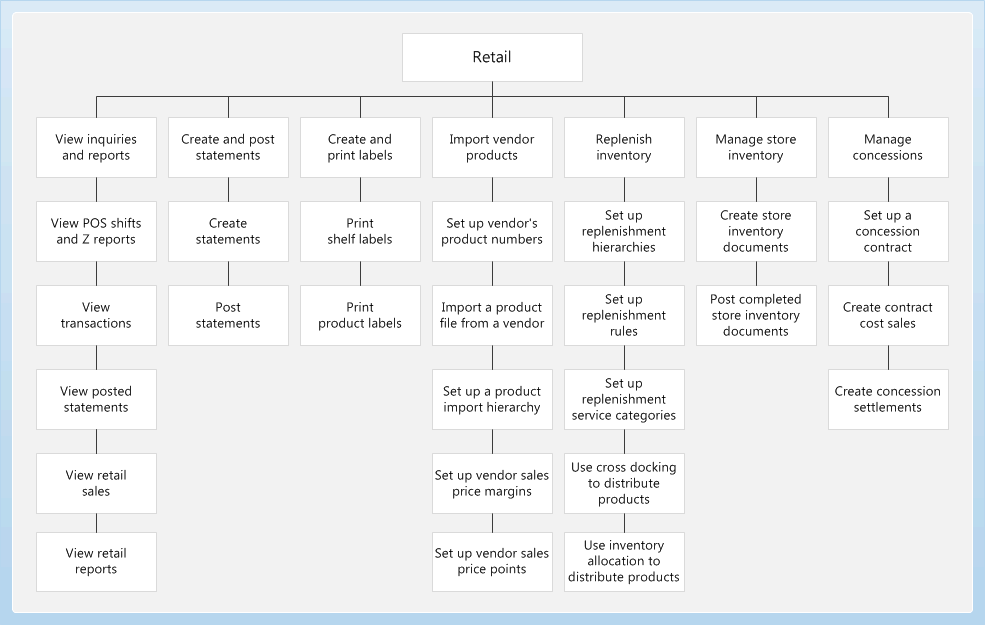What is “Retail”?
Retail is the sale of goods to the public in relatively small quantities for use or consumption rather than for resale. Or we can also say, It is the process of selling consumer goods and/or services to customers through multiple channels of distribution to earn a profit.
According to Wiki, the top ten Retailers are as below. Maybe this helps in understanding what is a Retail industry is all about.
| Worldwide Top Ten Retailers | ||
| Rank | Company | Country of Origin |
| 1 | Walmart | United States |
| 2 | Tesco | United Kingdom |
| 3 | Costco | United States |
| 4 | Carrefour | France |
| 5 | Kroger | United States |
| 6 | Amazon.com | United States |
| 7 | Lidl | Germany |
| 8 | Metro AG | Germany |
| 9 | The Home Depot | United States |
| 10 | Aldi | Germany |
So, Retail management: is basically the process of managing a Retail industry. And this is where Dynamics AX comes into picture. (Version: AX 2012 R3 CU8 onwards have several enhanced features in use for Retailers).
The above picture provides an illustration on what are the most important factors to be considered in Retail mgmt. Customers is the focus, Products and Suppliers are also very much needed. Also is the channel through which Retailer provides the Products to Customers.
Dynamics AX for Retail:
Dynamics AX is an ERP system that handles entire Business process, back office duties, most advanced Retail POS and packed with the Omni channel experience to the customers.
Microsoft Retail website is quite helpful if you are looking for an Overview of Dynamics AX for Retail implementations and module specific details.
If you would like to learn about Microsoft Dynamics AX Retail stories. You can do that from Clicking here. Just apply the necessary filter on the left hand pane and click search. Some most popular Customers are:
Dynamics AX Retail terminology:
Head office: From where the organization operates all its retail stores located in different geographical locations of the country.
Retail store: A store that is geographically located at a particular place. For an example: In a city, if a retailer has 3 outlets these are nothing but Retail stores in AX.
POS Register: At each store, there would be number of billing terminals which are called POS terminals.
Store database: Each store has a Store database where the necessary data from AX main database is replicated. Each POS can also work offline with an offline database at the POS, if needed.
By now, you might have realized that one important point to be noted is that there are lot of data push and pull operations to be performed in retail. Data to be transferred from Stores database to Headquarters and vice versa.
Some Examples of the data that should be transferred between store and headquarters:
- Sales data that is recorded at POS must be transferred to Head quarters
- Payment data and product receipts data that is recorded at POS.
- New Products that need to be released to stores.
- New store personnel data and credentials
- Offers and schemes related data that should be applied to stores and POS
Some Examples of the data that should be transferred between store and POS terminals:
- List of products
- POS Screen layout
- Employees who can login to POS
Operating model guideline for Retail:
Before going into the Technical details of Retail, it is important to get an understanding of the basic operating model for Retail.
Operating model is an abstract representation of how an organization operates across a range of domains in order to accomplish its function. The below picture illustrates Retail operating model.
We can split the Operating model logically as shown below:
Enterprise Foundation: Basically holds the Foundation information about the Business and Technology. This information is basic to kick start any operation.
Business foundation can consist of Finance, Human resources, Corporate support, even real estate. And the Technology foundation can consist of Infrastructure, Security, Integrations, Service mgmt., Device mgmt. and basic information.
Selling: The next logical section of the operating model can be “Selling”. As the name suggest, the focus here is to enable selling in the most efficient way. This will include Customer Service/experience, Customer support, Store, Master data management, Order processing and Financial services.
Movement: The retail organization is about reaching out the necessary products to the customers over locations and in necessary quantities. The “Movement” becomes an important logical section in this regards. This will include Supply chain mgmt., Asset and Fleet mgmt., Inventory mgmt., Distribution mgmt., Manufacturing, Network mgmt. and Fulfilment mgmt.
Plan & Buy: The next logical section should be planning and buying. In order to provide the necessary products to the customers, products have to be purchase from vendors with store specific planning. This will include Merchandising planning and mgmt., Marketing and Enterprise analytics.
Strategy: The final and most important logical section is Strategy, where the decisions are made based on roadmap and also historic data analytics. This section will include Corporate strategy, Customer and Brand strategy, Channel strategy, Portfolio strategy etc..
Hope this post helps. The idea was to give insights about Retail industry. I am working on Technical details of Dynamics AX for Retail and try to post more technical going forward. Happy DAXing.
Also here is a video with the high level goal of Microsoft for their aggressive approach with regards to Retail industry in here.
转载请注明:ww12345678 的部落格 | AX Helper » Retail understanding and AX Retail

